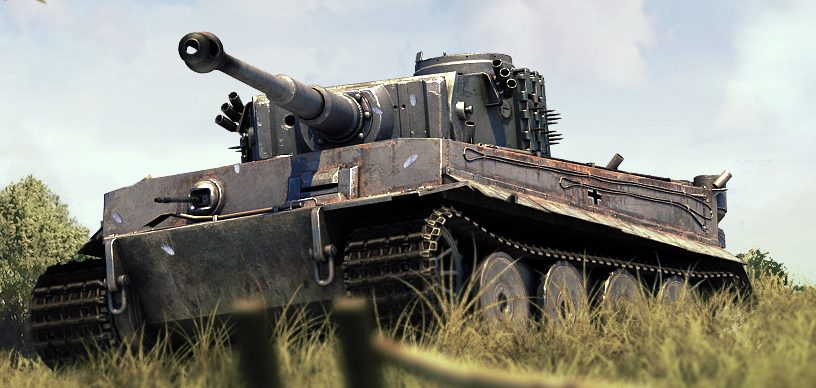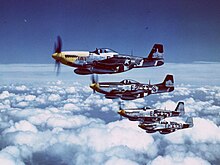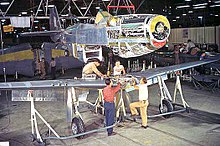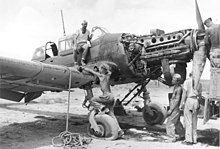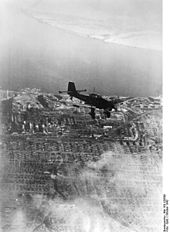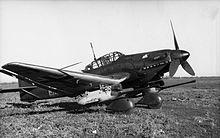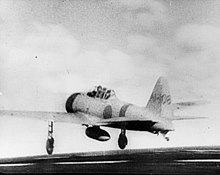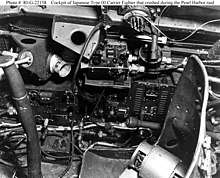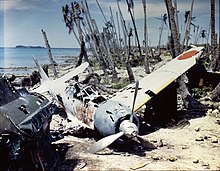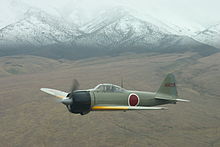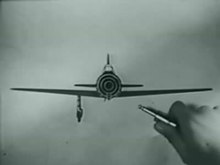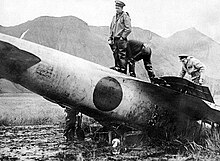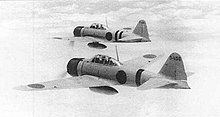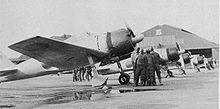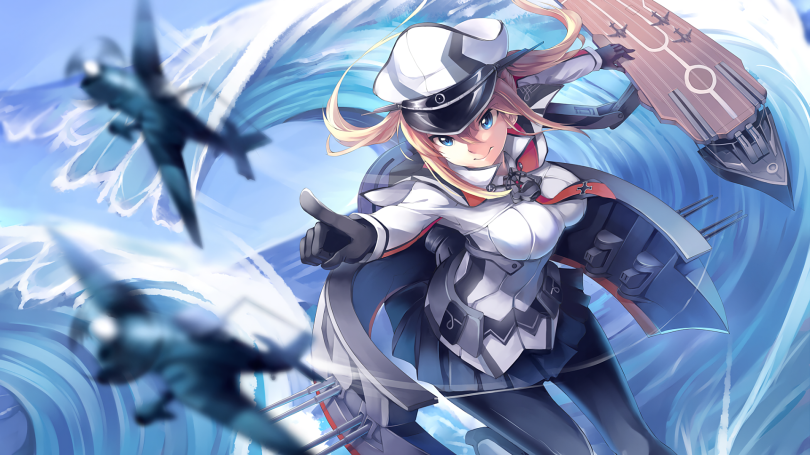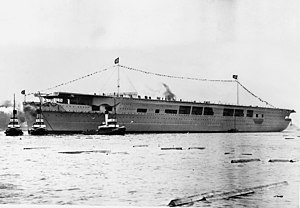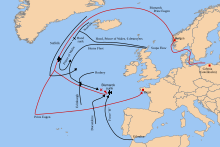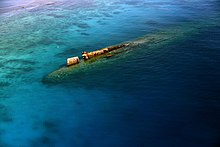North American P-51 Mustang
| P-51 Mustang | |
|---|---|
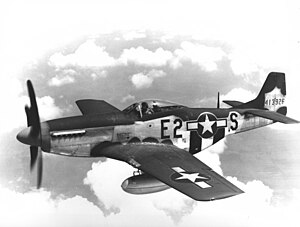 |
|
| P-51D of 375th Fighter Squadron, with underwing drop tanks. | |
| Role | Fighter |
| National origin | United States |
| Manufacturer | North American Aviation |
| First flight | 26 October 1940[1] |
| Introduction | January 1942 (RAF)[2] |
| Status | Retired from military service 1984 (Dominican Air Force)[3] |
| Primary users | United States Army Air Forces Royal Air Force Chinese Nationalist Air Force numerous others (see below) |
| Number built | More than 15,000[4] |
| Unit cost |
US$ 50,985 in 1945[5]
|
| Variants | North American A-36 Apache Rolls-Royce Mustang Mk.X Cavalier Mustang |
| Developed into | North American F-82 Twin Mustang Piper PA-48 Enforcer |
The North American Aviation P-51 Mustang is an American long-range, single-seat fighter and fighter-bomber used during World War II and the Korean War, among other conflicts. The Mustang was designed in 1940 by North American Aviation (NAA) in response to a requirement of the British Purchasing Commission. The Purchasing Commission approached North American Aviation to build Curtiss P-40 fighters under license for the Royal Air Force (RAF). Rather than build an old design from another company, North American Aviation proposed the design and production of a more modern fighter. The prototype NA-73X airframe was rolled out on 9 September 1940, 102 days after the contract was signed, and first flew on 26 October.[6][7]
The Mustang was originally designed to use the Allison V-1710 engine, which, in its earlier variants, had limited high-altitude performance. It was first flown operationally by the RAF as a tactical-reconnaissance aircraft and fighter-bomber (Mustang Mk I). The replacement of the Allison with a Rolls-Royce Merlin resulted in the P-51B/C (Mustang Mk III) model and transformed the Mustang’s performance at altitudes above 15,000 ft, allowing the aircraft to compete with the Luftwaffe‘s fighters.[8][nb 1] The definitive version, the P-51D, was powered by the Packard V-1650-7, a license-built version of the Rolls-Royce Merlin 66 two-stage two-speed supercharged engine and was armed with six .50 caliber (12.7 mm) M2/AN Browning machine guns.[10]
From late 1943, P-51Bs and Cs (supplemented by P-51Ds from mid-1944) were used by the USAAF’s Eighth Air Force to escort bombers in raids over Germany, while the RAF’s Second Tactical Air Force and the USAAF’s Ninth Air Force used the Merlin-powered Mustangs as fighter-bombers, roles in which the Mustang helped ensure Allied air superiority in 1944.[11] The P-51 was also used by Allied air forces in the North African, Mediterranean, Italian and Pacific theaters. During World War II, Mustang pilots claimed to have destroyed 4,950 enemy aircraft.[nb 2]
At the start of the Korean War, the Mustang, by then redesignated F-51, was the main fighter of the United Nations until jet fighters, including North American’s F-86, took over this role; the Mustang then became a specialized fighter-bomber. Despite the advent of jet fighters, the Mustang remained in service with some air forces until the early 1980s. After the Korean War, Mustangs became popular civilian warbirds and air racing aircraft.
Design and development
In April 1940[13] the British government established a purchasing commission in the United States, headed by Sir Henry Self.[14] Self was given overall responsibility for Royal Air Force (RAF) production and research and development, and also served with Sir Wilfrid Freeman, the Air Member for Development and Production. Self also sat on the British Air Council Sub-committee on Supply (or “Supply Committee”) and one of his tasks was to organize the manufacturing and supply of American fighter aircraft for the RAF. At the time, the choice was very limited, as no U.S. aircraft then in production or flying met European standards, with only the Curtiss P-40 Tomahawk coming close. The Curtiss-Wright plant was running at capacity, so P-40s were in short supply.[15]
North American Aviation (NAA) was already supplying its Harvard trainer to the RAF, but was otherwise underused. NAA President “Dutch” Kindelberger approached Self to sell a new medium bomber, the B-25 Mitchell. Instead, Self asked if NAA could manufacture P-40s under license from Curtiss. Kindelberger said NAA could have a better aircraft with the same Allison V-1710 engine in the air sooner than establishing a production line for the P-40. The Commission stipulated armament of four .303 in (7.7 mm) machine guns (as used on the Tomahawk), a unit cost of no more than $40,000 and delivery of the first production aircraft by January 1941.[16] In March 1940, 320 aircraft were ordered by Freeman, who had become the executive head of the Ministry of Aircraft Production and the contract was promulgated on 24 April.[17]
The NA-73X, which was designed by a team led by lead engineer Edgar Schmued, followed the best conventional practice of the era, but included several new features.[nb 3] One was a wing designed using laminar flow airfoils, which were developed co-operatively by North American Aviation and the National Advisory Committee for Aeronautics (NACA). These airfoils generated very low drag at high speeds.[18] During the development of the NA-73X, a wind tunnel test of two wings, one using NACA five-digit airfoils and the other using the new NAA/NACA 45–100 airfoils, was performed in the University of Washington Kirsten Wind Tunnel. The results of this test showed the superiority of the wing designed with the NAA/NACA 45–100 airfoils.[19][nb 4]
The other feature was a new cooling arrangement (aft positioned, single ducted water and oil radiators assembly) that reduced the cooling drag. Later [21] they discovered that, after much development, the cooling assembly could take advantage of the “Meredith effect“, in which heated air exited the radiator with a slight amount of jet thrust. Because NAA lacked a suitable wind tunnel to test this feature, it used the GALCIT 10 ft (3.0 m) wind tunnel at the California Institute of Technology. This led to some controversy over whether the Mustang’s cooling system aerodynamics were developed by NAA’s engineer Edgar Schmued or by Curtiss, although NAA had purchased the complete set of P-40 and XP-46 wind tunnel data and flight test reports for US$56,000.[22] The NA-73X was also one of the first aircraft to have a fuselage lofted mathematically using conic sections; this resulted in smooth, low drag surfaces.[23] To aid production, the airframe was divided into five main sections—forward, center, rear fuselage, and two wing halves—all of which were fitted with wiring and piping before being joined.[23]
The prototype NA-73X was rolled out in September 1940, just 102 days after the order had been placed; it first flew on 26 October 1940, 149 days into the contract, an uncommonly short development period, even during the war.[24] With test pilot Vance Breese at the controls,[25] the prototype handled well and accommodated an impressive fuel load. The aircraft’s three-section, semimonocoque fuselage was constructed entirely of aluminum to save weight. It was armed with four .30 caliber (7.62 mm) M1919 Browning machine guns in the wings and two .50 caliber (12.7 mm) M2 Browning machine guns mounted under the engine and firing through the propeller arc using gun-synchronizing gear.[nb 5]
While the United States Army Air Corps could block any sales it considered detrimental to the interests of the US, the NA-73 was considered to be a special case because it had been designed at the behest of the British. In September 1940, a further 300 NA-73s were ordered by the MAP.[16] To ensure uninterrupted delivery, Colonel Oliver P. Echolsarranged with the Anglo-French Purchasing Commission to deliver the aircraft and NAA gave two examples (41-038 and 41-039) to the USAAC for evaluation.[26][nb 6]
Operational history
United Kingdom operational service
The Mustang was initially developed for the RAF, which was its first user. As the first Mustangs were built to British requirements, these aircraft used factory numbers and were not P-51s; the order comprised 320 NA-73s, followed by 300 NA-83s, all of which were designated North American Mustang Mark I by the RAF.[28] The first RAF Mustangs supplied under Lend-Lease were 93 P-51s, designated Mk Ia, followed by 50 P-51As used as Mustang Mk IIs.[29] Aircraft supplied to Britain under Lend-Lease were required for accounting purposes to be on the USAAC’s books before they could be supplied to Britain. Lend-Lease aircraft destined for the RAF were first ordered and paid for on Britain’s behalf by the USAAC.[citation needed]
After the arrival of the initial aircraft in the UK in October 1941, the first Mustang Mk Is entered service in January 1942, the first unit being 26 Squadron RAF.[30] Due to poor high-altitude performance, the Mustangs were used by Army Co-operation Command, rather than Fighter Command, and were used for tactical reconnaissance and ground-attack duties. On 10 May 1942, Mustangs first flew over France, near Berck-sur-Mer.[31] On 27 July 1942, 16 RAF Mustangs undertook their first long-range reconnaissance mission over Germany. During the amphibious Dieppe Raid on the French coast (19 August 1942), four British and Canadian Mustang squadrons, including 26 Squadron, saw action covering the assault on the ground. By 1943–1944, British Mustangs were used extensively to seek out V-1 flying bomb sites. The last RAF Mustang Mk I and Mustang Mk II aircraft were struck off charge in 1945.
A Royal Air Force North American Mustang Mk III (FX908) on the ground at Hucknall
The RAF also operated 308 P-51Bs and 636 P-51Cs,[32] which were known in RAF service as Mustang Mk IIIs; the first units converted to the type in late 1943 and early 1944. Mustang Mk III units were operational until the end of World War II, though many units had already converted to the Mustang Mk IV (P-51D) and Mk IVa (P-51K) (828 in total, comprising 282 Mk IV and 600 Mk IVa).[33] As all except the earliest aircraft were obtained under Lend-Lease, all Mustang aircraft still on RAF charge at the end of the war were either returned to the USAAF “on paper” or retained by the RAF for scrapping. The last RAF Mustangs were retired from service in 1947.[34]
U.S. operational service
Prewar theory
Prewar doctrine was based on the idea “the bomber will always get through“.[35] Despite RAF and Luftwaffe experience with daylight bombing, the USAAC still believed in 1942 that tightly packed formations of bombers would have so much firepower that they could fend off fighters on their own.[35] Fighter escort was low-priority and when an escort fighter was planned in 1941, a heavy fighter with twin engines, such as the Lockheed P-38 Lightning, was considered to be most appropriate. Another school of thought favored a heavily up-armed “gunship” conversion of a strategic bomber.[36]A single-engined, high-speed fighter with the range of a bomber was thought to be an engineering impossibility.[37]
Eighth Air Force bomber operations 1942–1943
P-51 Mustangs of the 375th Fighter Squadron, Eighth Air Force mid-1944
The 8th Air Force started operations from Britain in August 1942. At first, because of the limited scale of operations, no conclusive evidence showed American doctrine was failing. In the 26 operations flown to the end of 1942, the loss rate had been under 2%.[38]
In January 1943, at the Casablanca Conference, the Allies formulated the Combined Bomber Offensive (CBO) plan for “round-the-clock” bombing – USAAF daytime operations complementing the RAF nighttime raids on industrial centers. In June 1943, the Combined Chiefs of Staff issued the Pointblank Directive to destroy the Luftwaffe’s capacity before the planned invasion of Europe, putting the CBO into full implementation. German daytime fighter efforts were, at that time, focused on the Eastern Front and several other distant locations. Initial efforts by the 8th met limited and unorganized resistance, but with every mission, the Luftwaffe moved more aircraft to the west and quickly improved their battle direction. In fall 1943, the 8th Air Force’s heavy bombers conducted a series of deep-penetration raids into Germany, beyond the range of escort fighters. The Schweinfurt–Regensburg mission in August lost 60 B-17s of a force of 376, the 14 October attacklost 77 of a force of 291—26% of the attacking force. Losses were so severe that long-range missions were called off for a time until an effective escort could be found.[39]
For the US, the very concept of self-defending bombers was called into question, but instead of abandoning daylight raids and turning to night bombing, as the RAF suggested, they chose other paths; at first, a bomber with more guns (the Boeing YB-40) was believed to be able to escort the bomber formations, but when the concept proved to be unsuccessful, thoughts then turned to the Lockheed P-38 Lightning.[40] In early 1943, the USAAF also decided that the Republic P-47 Thunderbolt and P-51B be considered for the role of a smaller escort fighter, and in July, a report stated that the P-51B was “the most promising plane” with an endurance of 4 hours 45 minutes with the standard internal fuel of 184 gallons plus 150 gallons carried externally.[41] In August, a P-51B was fitted with an extra internal 85-gallon tank, and although problems with longitudinal stability occurred and some compromises in performance with the tank full were made, and because the fuel from the fuselage tank would be used during the initial stages of a mission, the fuel tank would be fitted in all Mustangs destined for VIII Fighter Command.[42]
P-51 introduction
The P-51 Mustang was a solution to the need for an effective bomber escort. It used a common, reliable engine and had internal space for a large fuel load. With external fuel tanks, it could accompany the bombers from England to Germany and back.[43]
However, the Allison engine in the P-51A had a single-stage supercharger that caused power to drop off rapidly above 15,000 ft. This made it unsuitable for combat at the altitudes where USAAF bombers planned to fly. Following the RAF’s initial disappointing experience with the Mustang I (P-51A), Ronald Harker, a test pilot for Rolls-Royce, suggested fitting a Merlin 61, as fitted to the Spitfire Mk IX. The Merlin 61 had a two-speed, two-stage, intercooled supercharger, designed by Stanley Hooker of Rolls-Royce,[44] and this gave an increase in horsepower from the Allison’s 1,200 hp (895 kW) to 1,620 hp (1,208 kW) (1,720 hp in War Emergency Power) delivering an increase of top speed from 390 to 440 mph (340 to 380 kn; 630 to 710 km/h), as well as raising the service ceiling to almost 42,000 ft (12,800 m). Initial flights of what was known to Rolls-Royce as the Mustang Mk X were completed at Rolls-Royce’s airfield at Hucknall in October 1942.
At the same time, the possibility of combining the P-51 airframe with the US license-built Packard version of the Merlin engine was being explored on the other side of the Atlantic. In July 1942 a contract was let for two prototypes, briefly designated XP-78 but soon to become the XP-51B[45]. The first flight of the XP-51B took place in November 1942, but the USAAF was so interested in the possibility that an initial contract for 400 aircraft was placed three months beforehand in August.[46] The conversion led to production of the P-51B beginning at North American’s Inglewood, California, plant in June 1943,[47] and P-51s started to become available to the 8th and 9th Air Forces in the winter of 1943–1944. During the conversion to the two-stage, supercharged Merlin engine, which was slightly heavier than the single-stage Allison, so moved the aircraft’s centre-of-gravity forward, North American’s engineers took the opportunity to add a large additional fuselage fuel tank behind the pilot, greatly increasing the aircraft’s range over that of the earlier P-51A.[citation needed]
By the time the Pointblank offensive resumed in early 1944, matters had changed. Bomber escort defences were initially layered, using the shorter-range P-38s and P-47s to escort the bombers during the initial stages of the raid before handing over to the P-51s when they were forced to turn for home. This provided continuous coverage during the raid. The Mustang was so clearly superior to earlier US designs that the 8th Air Force began to steadily switch its fighter groups to the Mustang, first swapping arriving P-47 groups to the 9th Air Force in exchange for those that were using P-51s, then gradually converting its Thunderbolt and Lightning groups. By the end of 1944, 14 of its 15 groups flew the Mustang.[48]
The Luftwaffe’s twin-engined Messerschmitt Bf 110 heavy fighters brought up to deal with the bombers proved to be easy prey for the Mustangs, and had to be quickly withdrawn from combat. The Focke-Wulf Fw 190A, already suffering from poor high-altitude performance, was outperformed by the Mustang at the B-17’s altitude, and when laden with heavy bomber-hunting weapons as a replacement for the more vulnerable twin-engined Zerstörer heavy fighters, it suffered heavy losses. The Messerschmitt Bf 109 had comparable performance at high altitudes, but its lightweight airframe was even more greatly affected by increases in armament. The Mustang’s much lighter armament, tuned for antifighter combat, allowed it to overcome these single-engined opponents.
Fighting the Luftwaffe
Pilots of the all-Black American 332nd Fighter Group (the Tuskegee Airmen) at Ramitelli, Italy: From left, Lt. Dempsey W. Morgran, Lt. Carroll S. Woods, Lt. Robert H. Nelron, Jr., Capt. Andrew D. Turner, and Lt. Clarence P. Lester
At the start of 1944, Major General James Doolittle, the new commander of the 8th Air Force, ordered many fighter pilots to stop flying in formation with the bombers and instead attack the Luftwaffe wherever it could be found. The aim was to achieve air supremacy. Mustang groups were sent far ahead of the bombers in a “fighter sweep” in order to intercept attacking German fighters.
The Luftwaffe answered with the Gefechtsverband (“battle formation”). This consisted of a Sturmgruppe of heavily armed and armored Fw 190As escorted by two Begleitgruppen of Messerschmitt Bf 109s, whose task was to keep the Mustangs away from the Fw 190As attacking the bombers. This strategy proved to be problematic, as the large German formation took a long time to assemble and was difficult to maneuver. It was often intercepted by the P-51 “fighter sweeps” before it could attack the bombers. However, German attacks against bombers could be effective when they did occur; the bomber-destroyer Fw 190As swept in from astern and often pressed their attacks to within 100 yd (91 m).[49]
While not always able to avoid contact with the escorts, the threat of mass attacks and later the “company front” (eight abreast) assaults by armored Sturmgruppe Fw 190As brought an urgency to attacking the Luftwaffe wherever it could be found, either in the air or on the ground. Beginning in late February 1944, 8th Air Force fighter units began systematic strafing attacks on German airfields with increasing frequency and intensity throughout the spring, with the objective of gaining air supremacy over the Normandy battlefield. In general these were conducted by units returning from escort missions but, beginning in March, many groups also were assigned airfield attacks instead of bomber support. The P-51, particularly with the advent of the K-14 Gyro gunsightand the development of “Clobber Colleges” for the training of fighter pilots in fall 1944, was a decisive element in Allied countermeasures against the Jagdverbände.
The numerical superiority of the USAAF fighters, superb flying characteristics of the P-51, and pilot proficiency helped cripple the Luftwaffe’s fighter force. As a result, the fighter threat to US, and later British, bombers was greatly diminished by July 1944. The RAF, long proponents of night bombing for protection, were able to reopen daylight bombing in 1944 as a result of the crippling of the Luftwaffe fighter arm. Reichsmarschall Hermann Göring, commander of the German Luftwaffe during the war, was quoted as saying, “When I saw Mustangs over Berlin, I knew the jig was up.”[50][51][52]
Beyond Pointblank
P-51D 44-14888 of the 8th AF/357th FG/363rd FS, named Glamorous Glen III, is the aircraft in which Chuck Yeager achieved most of his 12.5 kills, including two Me 262s – shown here with twin 108-gallon (409-l) drop tanks fitted.
On 15 April 1944, VIII Fighter Command began “Operation Jackpot”, attacks on Luftwaffe fighter airfields. As the efficacy of these missions increased, the number of fighters at the German airbases fell to the point where they were no longer considered worthwhile targets. On 21 May, targets were expanded to include railways, locomotives, and rolling stock used by the Germans to transport materiel and troops, in missions dubbed “Chattanooga”.[53] The P-51 excelled at this mission, although losses were much higher on strafing missions than in air-to-air combat, partially because the Mustang’s liquid-cooled engine (particularly its coolant system) was vulnerable to small-arms fire, unlike the air-cooled R-2800 radials of its Republic P-47 Thunderbolt stablemates based in England, regularly tasked with ground-strafing missions.
P-51D Mustang Detroit Miss of the 375th Fighter Squadron: Urban L. Drew flew this aircraft in the autumn 1944 and shot down six German aircraft, including two jet-powered Me-262s in a single mission.
Given the overwhelming Allied air superiority, the Luftwaffe put its effort into the development of aircraft of such high performance that they could operate with impunity, but which also made bomber attack much more difficult, merely from the flight velocities they achieved. Foremost among these were the Messerschmitt Me 163B point-defense rocket interceptors, which started their operations with JG 400 near the end of July 1944, and the longer-endurance Messerschmitt Me 262A jet fighter, first flying with the Gruppe-strength Kommando Nowotnyunit by the end of September 1944. In action, the Me 163 proved to be more dangerous to the Luftwaffe than to the Allies, and was never a serious threat. The Me 262A was a serious threat, but attacks on their airfields neutralized them. The pioneering Junkers Jumo 004 axial-flowjet engines of the Me 262As needed careful nursing by their pilots, and these aircraft were particularly vulnerable during takeoff and landing.[54] Lt. Chuck Yeager of the 357th Fighter Group was one of the first American pilots to shoot down an Me 262, which he caught during its landing approach. On 7 October 1944, Lt. Urban L. Drew of the 361st Fighter Group shot down two Me 262s that were taking off, while on the same day Lt. Col. Hubert Zemke, who had transferred to the Mustang-equipped 479th Fighter Group, shot down what he thought was a Bf 109, only to have his gun camera film reveal that it may have been an Me 262.[55] On 25 February 1945, Mustangs of the 55th Fighter Group surprised an entire Staffel of Me 262As at takeoff and destroyed six jets.[56]
The Mustang also proved useful against the V-1s launched toward London. P-51B/Cs using 150-octane fuel were fast enough to catch the V-1 and operated in concert with shorter-range aircraft such as advanced marks of the Supermarine Spitfire and Hawker Tempest.
By 8 May 1945,[57] the 8th, 9th, and 15th Air Force‘s P-51 groups [nb 7] claimed some 4,950 aircraft shot down (about half of all USAAF claims in the European theater, the most claimed by any Allied fighter in air-to-air combat)[57] and 4,131 destroyed on the ground. Losses were about 2,520 aircraft.[58] The 8th Air Force’s 4th Fighter Group was the top-scoring fighter group in Europe, with 1,016 enemy aircraft claimed destroyed. This included 550 claimed in aerial combat and 466 on the ground.[59]
In air combat, the top-scoring P-51 units (both of which exclusively flew Mustangs) were the 357th Fighter Group of the 8th Air Force with 565 air-to-air combat victories and the 9th Air Force’s 354th Fighter Group with 664, which made it one of the top-scoring fighter groups. The top Mustang ace was the USAAF’s George Preddy, whose final tally stood at 26.83 victories (a number that includes shared one half- and one third victory credits), 23 of which were scored with the P-51. Preddy was shot down and killed by friendly fire on Christmas Day 1944 during the Battle of the Bulge.[57]
In China and the Pacific Theater
A P-51 takes off from Iwo Jima.
In early 1945, P-51C, D, and K variants also joined the Chinese Nationalist Air Force. These Mustangs were provided to the 3rd, 4th, and 5th Fighter Groups and used to attack Japanese targets in occupied areas of China. The P-51 became the most capable fighter in China, while the Imperial Japanese Army Air Force used the Nakajima Ki-84 Hayate against it.
The P-51 was a relative latecomer to the Pacific Theater, due largely to the need for the aircraft in Europe, although the P-38’s twin-engined design was considered a safety advantage for long, over-water flights. The first P-51s were deployed in the Far East later in 1944, operating in close-support and escort missions, as well as tactical photo reconnaissance. As the war in Europe wound down, the P-51 became more common; eventually, with the capture of Iwo Jima, it was able to be used as a bomber escort during Boeing B-29 Superfortress missions against the Japanese homeland.
The P-51 was often mistaken for the Japanese Kawasaki Ki-61 Hien in both China and Pacific because of its similar appearance.
Pilot observations
Chief Naval Test Pilot and C.O. Captured Enemy Aircraft Flight Capt. Eric Brown, CBE, DSC, AFC, RN, tested the Mustang at RAE Farnborough in March 1944 and noted, “The Mustang was a good fighter and the best escort due to its incredible range, make no mistake about it. It was also the best American dogfighter. But the laminar-flow wing fitted to the Mustang could be a little tricky. It could not by any means out-turn a Spitfire. No way. It had a good rate-of-roll, better than the Spitfire, so I would say the plusses to the Spitfire and the Mustang just about equate. If I were in a dogfight, I’d prefer to be flying the Spitfire. The problem was I wouldn’t like to be in a dogfight near Berlin, because I could never get home to Britain in a Spitfire!”[60]
The U.S. Air Forces, Flight Test Engineering, assessed the Mustang B on 24 April 1944 thus: “The rate of climb is good and the high speed in level flight is exceptionally good at all altitudes, from sea level to 40,000 feet. The airplane is very maneuverable with good controllability at indicated speeds up to 400 MPH [sic]. The stability about all axes is good and the rate of roll is excellent; however, the radius of turn is fairly large for a fighter. The cockpit layout is excellent, but visibility is poor on the ground and only fair in level flight.”[61]
Kurt Bühligen, the third-highest scoring German fighter pilot of World War II’s Western Front (with 112 confirmed victories, three against Mustangs), later stated, “We would out-turn the P-51 and the other American fighters, with the Bf 109 or the Fw 190. Their turn rate was about the same. The P-51 was faster than us, but our munitions and cannon were better.”[62][63] Heinz Bär said that the P-51 “was perhaps the most difficult of all Allied aircraft to meet in combat. It was fast, maneuverable, hard to see, and difficult to identify because it resembled the Me 109”.[64]
Post-World War II
In the aftermath of World War II, the USAAF consolidated much of its wartime combat force and selected the P-51 as a “standard” piston-engined fighter, while other types, such as the P-38 and P-47, were withdrawn or given substantially reduced roles. As the more advanced (P-80 and P-84) jet fighters were introduced, the P-51 was also relegated to secondary duties.
In 1947, the newly formed USAF Strategic Air Command employed Mustangs alongside F-6 Mustangs and F-82 Twin Mustangs, due to their range capabilities. In 1948, the designation P-51 (P for pursuit) was changed to F-51 (F for fighter) and the existing F designator for photographic reconnaissance aircraft was dropped because of a new designation scheme throughout the USAF. Aircraft still in service in the USAF or Air National Guard (ANG) when the system was changed included: F-51B, F-51D, F-51K, RF-51D (formerly F-6D), RF-51K(formerly F-6K) and TRF-51D (two-seat trainer conversions of F-6Ds). They remained in service from 1946 through 1951. By 1950, although Mustangs continued in service with the USAF after the war, the majority of the USAF’s Mustangs had become surplus to requirements and placed in storage, while some were transferred to the Air Force Reserve and the ANG.
From the start of the Korean War, the Mustang once again proved useful. A substantial number of stored or in-service F-51Ds were shipped, via aircraft carriers, to the combat zone, and were used by the USAF, the South African Air Force, and the Republic of Korea Air Force (ROKAF). The F-51 was used for ground attack, fitted with rockets and bombs, and photo reconnaissance, rather than being as interceptors or “pure” fighters. After the first North Korean invasion, USAF units were forced to fly from bases in Japan and the F-51Ds, with their long range and endurance, could attack targets in Korea that short-ranged F-80 jets could not. Because of the vulnerable liquid cooling system, however, the F-51s sustained heavy losses to ground fire.[4] Due to its lighter structure and a shortage of spare parts, the newer, faster F-51H was not used in Korea.
Mustangs continued flying with USAF and ROKAF fighter-bomber units on close support and interdiction missions in Korea until 1953, when they were largely replaced as fighter-bombers by USAF F-84s and by United States Navy (USN) Grumman F9F Panthers. Other air forces and units using the Mustang included the Royal Australian Air Force‘s 77 Squadron, which flew Australian-built Mustangs as part of British Commonwealth Forces Korea. The Mustangs were replaced by Gloster Meteor F8s in 1951. The South African Air Force‘s 2 Squadron used U.S.-built Mustangs as part of the U.S. 18th Fighter Bomber Wing and had suffered heavy losses by 1953, after which 2 Squadron converted to the F-86 Sabre.
F-51s flew in the Air Force Reserve and ANG throughout the 1950s. The last American USAF Mustang was F-51D-30-NA AF serial no. 44-74936, which was finally withdrawn from service with the West Virginia Air National Guard‘s 167th Fighter Interceptor Squadron in January 1957 and retired to what was then called the Air Force Central Museum,[65]although it was briefly reactivated to fly at the 50th anniversary of the Air Force Aerial Firepower Demonstration at the Air Proving Ground, Eglin AFB, Florida, on 6 May 1957.[66] This aircraft, painted as P-51D-15-NA serial no. 44-15174, is on display at the National Museum of the United States Air Force, Wright-Patterson AFB, in Dayton, Ohio.[67]
The final withdrawal of the Mustang from USAF dumped hundreds of P-51s onto the civilian market. The rights to the Mustang design were purchased from North American by the Cavalier Aircraft Corporation, which attempted to market the surplus Mustang aircraft in the U.S. and overseas. In 1967 and again in 1972, the USAF procured batches of remanufactured Mustangs from Cavalier, most of them destined for air forces in South America and Asia that were participating in the Military Assistance Program (MAP). These aircraft were remanufactured from existing original F-51D airframes fitted with new V-1650-7 engines, a new radio, tall F-51H-type vertical tails, and a stronger wing that could carry six 0.50 in (13 mm) machine guns and a total of eight underwing hardpoints. Two 1,000-pound (450 kg) bombs and six 5 in (130 mm) rockets could be carried. They all had an original F-51D-type canopy, but carried a second seat for an observer behind the pilot. One additional Mustang was a two-seat, dual-control TF-51D (67-14866) with an enlarged canopy and only four wing guns. Although these remanufactured Mustangs were intended for sale to South American and Asian nations through the MAP, they were delivered to the USAF with full USAF markings. They were, however, allocated new serial numbers (67-14862/14866, 67-22579/22582 and 72-1526/1541).[67]
The last U.S. military use of the F-51 was in 1968, when the U. S. Army employed a vintage F-51D (44-72990) as a chase aircraft for the Lockheed YAH-56 Cheyenne armed helicopter project. This aircraft was so successful that the Army ordered two F-51Ds from Cavalier in 1968 for use at Fort Rucker as chase planes. They were assigned the serials 68-15795 and 68-15796. These F-51s had wingtip fuel tanks and were unarmed. Following the end of the Cheyenne program, these two chase aircraft were used for other projects. One of them (68-15795) was fitted with a 106 mm recoilless rifle for evaluation of the weapon’s value in attacking fortified ground targets.[68] Cavalier Mustang 68-15796 survives at the Air Force Armament Museum, Eglin AFB, Florida, displayed indoors in World War II markings.
The F-51 was adopted by many foreign air forces and continued to be an effective fighter into the mid-1980s with smaller air arms. The last Mustang ever downed in battle occurred during Operation Power Pack in the Dominican Republic in 1965, with the last aircraft finally being retired by the Dominican Air Force in 1984.[69]
